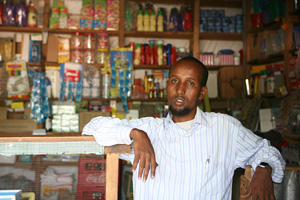
“The number has skyrocketed,” a registration expert with the UN Refugee Agency, UNHCR, told IRIN.
The official, who declined to be named, said UNHCR had had to hire more employees, who now work in shifts, to accommodate the rush.
The three Dadaab refugee camps – Dagahaley, Ifo and Hagadera – were originally meant to cater for 90,000 refugees, but housed at least 380,000 people, according to UNHCR.
Despite the overcrowding, the government of Kenya has yet to allow people to move into a fourth camp, known as Ifo II, which stands empty.
“Water systems, latrines and healthcare facilities are ready to use but are standing idle,” Oxfam said in a statement.
Oxfam reported that 60,000 new arrivals were living in basic tents outside the camp boundaries, with limited access to clean water or latrines, risking an outbreak of disease.
Malnutrition
Those living in these informal settlements are some of the worst-off. In the settlements on the outskirts of Dagahaley camp, 17.5 percent of children between six months and almost five years old are severely malnourished, three times the emergency level, according to Caroline Abu-Sada, a research unit coordinator with Médecins Sans Frontières (MSF).
Rates of malnutrition are lower at the reception centres than in the outskirt settlements, according to MSF, indicating that children are deteriorating quickly after their arrival at Dadaab due to a lack of access to clean water and nutritious food adapted to their special needs.
“We drank some tea this morning, but we have very little food,” Madina Farah Yusuf, a Somali refugee with four foster children, told Oxfam. “The rations are not enough for everyone to eat every day.”
A rapid nutrition assessment by MSF showed that more than 43 percent of children in the Dagahaley outskirts aged six to 10 years were [also] malnourished. This age group is not usually included at all in nutrition programmes. Abu-Sada said even refugees who had lived in the camp for years had deteriorating nutritional status because they were sharing food with newcomers.
In response, MSF is increasing its capacity, opening a sixth health outpost, recruiting more community health workers, and attending medical screenings at refugees’ arrival.
The lack of water in the outskirts was a real concern. Refugees are only able to obtain up to three litres of water a day, 80 percent less than they need according to the Sphere Standards, which are already based on emergency situations. Some are only receiving 500ml for drinking, bathing, washing clothes, and everything else.
By comparison, in North America and Japan most people use 350l a day, according to the World Water Council.
Risk of disease
Water is now being trucked to the camp outskirts by MSF and CARE, but there were previously only 48 taps for 20,000 people. Abu-Sada said diarrhoea was already rampant, along with skin rashes and respiratory infections.
She said a family with six children came to the clinic; two children were infected with chicken pox and the others had various ailments. MSF gave them all medicine, but the family had no containers to carry water to help take it.
Abu-Sada said the lack of clean water, adequate sanitation and nutritious food was just increasing the vulnerability of people who were already weak.
That threat is compounded by the fact that only 65 percent of the refugees have been vaccinated against measles. “With the massive influx, we’re way below coverage to avoid an outbreak,” she said. The disease is so contagious that just one infected child is considered an outbreak.
Locals suffering
Outside the camp, the host population is not faring much better. An MSF nutrition assessment showed that the local community was suffering from malnutrition at the same rates as the refugees living in camp outskirts, and people had stopped feeding their animals in order to have enough food for themselves.
Half the people arriving in villages near the camps came from the Kenyan countryside, according to Abu-Sada, unable to qualify as refugees and officially obtain the corresponding food and medical aid.
The UNHCR registration expert said many Kenyans attempted to register as refugees to obtain aid. Kenyans just outside the camp have to pay for water, schooling and medicine while people inside the camps get them for free. Despite the fact that education opportunities in the camp are meagre, those whose children are left out still perceive an injustice.
“They get free and better education and healthcare,” said local shopkeeper Deckon Sirad Salah, who was a young boy when the first refugees arrived in Dadaab. “Livelihoods are even better in the camp,” he said.
The local community used to graze their animals on the land now occupied by refugees, who also cut down surrounding trees for firewood.
Salah also believed new arrivals were to blame for growing insecurity in Dadaab town, and suggested refugees who were not receiving enough food were responsible for an uptick in store robberies, animal raids, and arms dealing. It was a problem when the camp was first created in the early 1990s, he said. “The new influx is taking us back to those bad old days.”
Sahara Dhubou, a mother and vegetable seller, also noticed a change in the town’s security. She couldn’t prove the new refugees were the culprits, but said that “before the new arrivals came, there was peace”. Now, she says, “there is fear in the night”.
Salah blamed the aid agencies who worked in the area, saying if the refugees were being provided for they would not need to steal from the host population.
“It’s a natural disaster that brought them here and we locals are very sympathetic and willing to welcome them,” said Salah. “We know there’s no way for them to go back.”
IRIN News
jb/am/mw/bp
Theme (s): Children, Health & Nutrition, Refugees/IDPs, Water & Sanitation,
[This report does not necessarily reflect the views of the United Nations]
